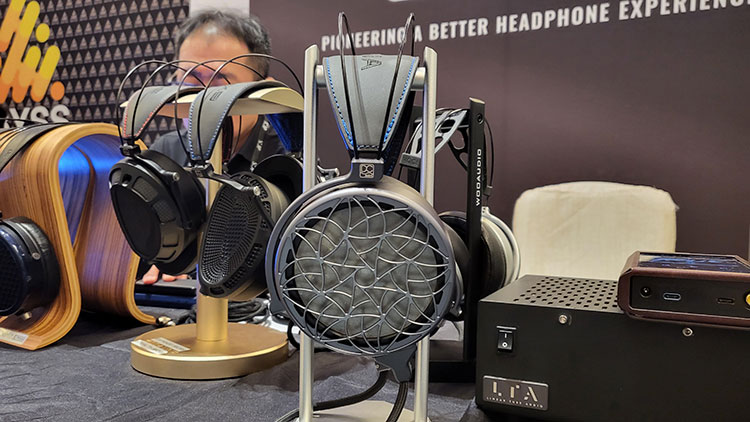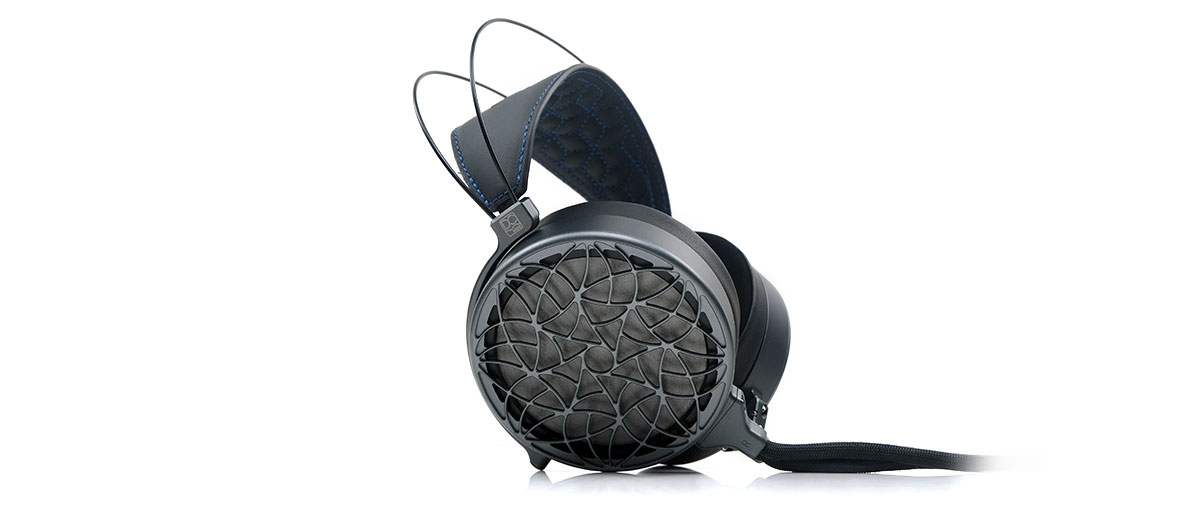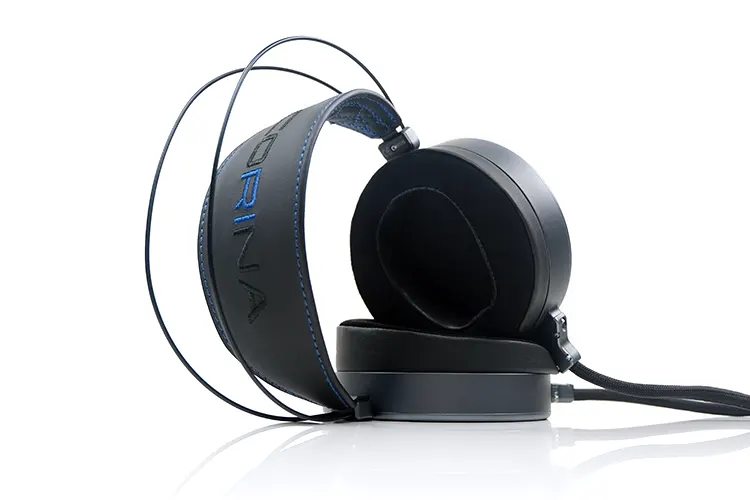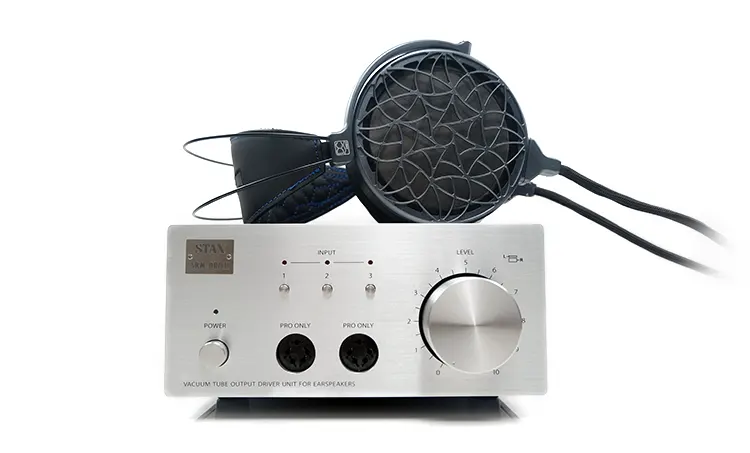Sound Impressions
The following sound impressions were created using a HIFIMAN Shangri-La and a Stax SRM-007tII tube energizer alongside a Musician Audio Aquarius and Ladder Schumann R-2R DAC as the source decoder. Both amplifiers were fed balanced analog inputs from each DAC.
Summary
The Dan Clark Audio CORINA pretty much synchronizes the last outlier in their product lineup to what I consider to be the DCA signature sound moving forward for the last 18 months.
What does that mean? Well, the CORINA is now more Harman Target sensitive with a smooth and at times effortless delivery offering a rich and fulsome midrange and surprisingly great bass weight for electrostatic headphones.
Of all of my electrostatic headphones out there, this sounds the least like that classic ethereal and perhaps treble-abundant tuning you might have expected to hear.
The treble tuning is decidedly relaxed favoring a bass to mids emphasis that gives it a pleasing sense of ‘drive’ to its performance with rhythmic tracks. Your ear is going to gravitate further south as a result of that slightly darker tuning so it is very gratifying to hear a timbre that is dissonance free and very natural-sounding.
The detail is there, but it’s not an exaggerated response in the highs to tease that detail out. Percussion notes have some nice weight and plenty of detail in their sustain but with a slight bias to their lower harmonic order so it sounds planted and firm rather than airy and fleet of foot.
Even compared to the VOCE, a headphone I originally described as being surprisingly smooth in its tuning, the CORINA is a double-down on that theme and at the same time, produces a more focused and coherent presentation whilst improving on the VOCE’s midrange performance substantially.
One thing to note, from my energizer testing the CORINA does need a good level of voltage swing to get the best out of it. Its forte should be staging depth but a lack of power can shrink that staging and give a flat response.
Frequency Response
From about 100Hz up to almost 5k, the CORINA runs very close to the ideal Harman Target Response curve. The exception is the sub-bass weight which does not offer the same higher dB shelf as the curve might indicate.
That is not an unusual experience with most e-stat headphones a bit light on the sub-bass response though for me the CORINA is heftier sounding carrying more warmth and body from an elevated 200Hz to 800Hz response.
The second is the treble tuning which runs south of the curve from 5k onwards with a fairly flat and linear 7-10k line and some good energy post 12k. The clarity is good but it is unlikely that this type of relaxed FR will appeal to die-hard treble heads or those who look to e-stats for infinite sparkling overtones.
There is also a little bump just north of the lower-mids curve around 800Hz-1k which I find to work very nicely for lower pitching vocals to have a natural level of presence. It also picks up on a little more warmth from CORINA bass tuning to give them a very natural but not overly soft sound.
Compared to alternatives such as the CRBN and the Shangri-La Jr, the CORINA stays fairly disciplined through the 2-4k range so you will not find the vocal imaging to dominate and some nice presence or fill for percussion energy at around 4-5k.
I think that helps get the balance between the vocal and instrumental imaging just right and does add a bit more perceived complexity in the CORINA’s soundstage along the X-axis.
Timbre
The CORINA is a smooth and full-sounding headphone lacking in any sharp treble overtones with a stronger even harmonic bias that pushes it to a slightly darker sound signature than your typical electrostatic headphone.
Notes are weighted with a solid fundamental though it’s still an electrostatic type of delivery with notes presented rather than rammed down your ear so it’s not the same level of physicality if you are coming from a dynamic or planar driver.
I could best describe the lower register coloration or performance as denser and more powerful than you might expect which makes the CORINA more apt to modern pop and rock in a similar vein to how I felt about the Audeze CRBN tuning. If anything, I find the note density and perceived slam a little stronger than the CRBN.
The mids are ‘big sounding’ and slightly rounded in their delivery but more on the lower mids which pick up on that bass warmth a bit more giving stringed instrument plucks some richness.
There is less of a treble edge to the upper mids though that additional 4-5k energy in the CORINA’s tuning helps a lot to flesh out the percussion presence. Cymbal notes have a good level of body with minimal contrast and with more of a focus on the underlying weight of the hit than any lingering bite or fizz.
Sibilance is minimal though solid-state energizers will bring a cooler element to the performance so it is possible to pick up on any natural sibilant overtones a bit more compared to sweeter-sounding tube alternatives.
Staging & Dynamics
This is where I think the CORINA will win over a lot of fans new to electrostatic headphones, or those looking for something a bit different from a typical airy e-stat presentation.
I find the staging an improvement on the VOCE with more of a convex staging shape to it than the VOCE’s concave imaging experience.
That means better support to the midrange and vocal notes and more of what I describe on page 3 as a crossfeed speaker type of response. There is less of an extreme left-right stereo field compared to the VOCE which pushes out pretty wide but leaves a bit of weakness in the mids presence as a result.
The CORINA also sounds a little deeper and firmer than both the CRBN and the Shangri-La Jr, with a stronger lower-mid presence for instruments and lower register vocals over the HIFIMAN which images a bit flatter here for me.
Vocals sit just a shade further back compared to the CRBN but its stronger elevation through the 4-5k range allows vocals to mix more freely with surround instruments giving them a bit more presence as a result.
The CRBN supporting instruments seem to just sit behind a little relative to the vocal giving it a slightly narrower but taller staging quality compared to the CORINA.
It is not as airy and ethereal sounding as the Jr but it successfully avoids that slightly metallic after-effect of the Stax SRM-007 MK2’s overly boosted 8-10k treble tuning. Your listening attention will be drawn more to the CORINA bass and mids presence, rather than anything screeching at you from the highs.
Just watch that amp matching for dynamic headroom and separation capability from the CORINA. The better the voltage swing the more holographic the staging performance sounds.

Synergy
Efficiency
The size of the driver combined with the increased 0.58mm spacing between it and the stator does mean that the CORINA needs a decent level of voltage swing to give it enough dynamic headroom to perform optimally.
I do suspect on that basis a lot of my electrostatic amplifiers are more aligned to efficient drivers from Stax and HIFIMAN because during testing volume level and dynamic range did seem an issue.
For example, both the Stax SRM-007tII and Hifiman’s own Shangri-La Jr hybrid tube amplifier coped the best in terms of dynamic range but at higher volume, there was an element of distortion creeping in.
And when I mean higher volume, both amps could feasibly go right to their limits with the CORINA and I still felt you might need more voltage swing.
That may also be a mirage of sorts given treble sensitivity can lead to increased volume levels with headphones such as the Shangri-La Jr. With the CORINA’s smoother more relaxed treble you might find yourself willing to move the volume up a bit higher.
If you are coming from Audeze’s CRBN the performance is quite similar so portable units such as the Stax SRM-D10 solid-state energizer are going to distort the CORINA presentation significantly before any optimal dynamic headroom is achieved.

Alternatives
From what I know at this stage, Topping has just launched a very strong peak-to-peak budget electrostatic amplifier called the EHA5 that might give you more headroom but I have yet to test it.
Other options I am fairly sure will improve on this include Linear Tube Audio‘s excellent Z10e which I tested at CanJam Singapore 2023 and the Blue Hawaii which is also sold by DCA and is an electrostatic fan favorite but both will cost you significantly more than the Topping.
I was also informed that boutique Kevin Gilmore-designed amps like the Carbon or KSSV, as well as the Stax T8000 really drive the CORINA quite well, as does the 700T or 700S models.
Pairings
I suspect much of the above will have a bearing on your choices and dynamic range and controllable volume without distortion is where I would normally start with when using a decent electrostatic headphone.
HIFIMAN
I tested 4 energizers of varying quality and power and that voltage swing was the first thing I noticed though I also felt that a solid-state rectifier might also suit those who want to tease out a bit more bite from the upper mids and treble of the CORINA.
For example, the HIFIMAN Shangri-La Jr energizer did the best of the four for separation and dynamic range though the volume level is up pretty high with our source DAC the R-2R Musician Audio Aquarius connected.
Vocals and bass depth in particular had the best presence and weight with the CORINA out of the four amplifier match-ups. This is a tube amplifier and will retain that smooth and rich tone from the CORINA almost perfectly.
Stax
The Stax SRM-007tII was connected to another R-2R DAC, the Ladder Schumann and this played a bit more neutral than the HIFIMAN amplifier though still a tube sound signature in the way vocal notes break and decay.
What I did notice from this pair-up was just a little less staging depth from the CORINA with a less immersive presentation. I had this tendency to edge the volume forward bit by bit to compensate but I suspect moving to a stronger DAC/pre-amp such as the Cayin iDAC-6 MK2 would be a better choice.
The reason I say this is because I have had this old Stax SRM-313 for years now and with a regular 2Vrms line-in from the iDAC-6 MK2 transistor mode, the performance felt lacking.
The pre-amp output of the same DAC with a much higher Vrms provided a livelier solid-state sound. Of the four energizers, it was the cleanest sounding though still behind the HIFIMAN for overall headroom.
I would not bother pairing the portable Stax SRM-D10 with the CORINA, even with a good line in. Volume control is just ok but starts to distort quickly beyond 1 pm on the dial. The volume levels are satisfactory at around noon but whilst it’s clean-toned, it’s also a shallow performance and you can tell the CORINA needs better voltage swing for it to sound optimal.





